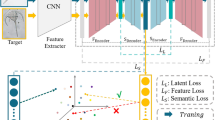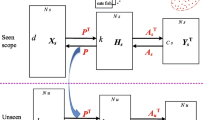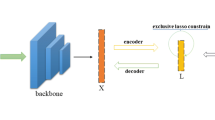Abstract
Existing zero-shot recognition (ZSR) approaches generally learn a projection function from the labelled training (source) dataset. However, applying the learned projection function without adaptation to the test (target) dataset is prone to the domain shift problem. In this paper, we propose a semantic double-autoencoder with attribute constraint (SDAWAC) mechanism to overcome the problem effectively. Specifically, we take the semantic encoder-decoder paradigm to learn a projection function in the source and target domains simultaneously. In addition, we introduce one constraint on source domain attributes into this work to improve the performance of our model. The experimental results on three benchmark datasets demonstrate the efficacy of our proposed method.
Access this chapter
Tax calculation will be finalised at checkout
Purchases are for personal use only
Similar content being viewed by others
References
Zhang, Z., Saligrama, V.: Zero-shot learning via joint latent similarity embedding. In: Proceedings of the IEEE Conference on Computer Vision and Pattern Recognition, pp. 6034–6042 (2016)
Romera-Paredes, B., Torr, P.H.: An embarrassingly simple approach to zero-shot learning. In: 32th IEEE International Conference on Machine Learning, pp. 2152–2561 (2015)
Akata, Z., Perronnin, F., Harchaoui, Z, Schmid, C.: Label embedding for attribute-based classification. In: Proceedings of the IEEE Conference on Computer Vision and Pattern Recognition, pp. 819–826 (2013)
Wang, X., Ji, Q.: A unified probabilistic approach modelling relationships between attributes and objects. In: Proceedings of the IEEE International Conference on Computer Vision, pp. 2120–2127 (2013)
Bucher, M., Herbin, S., Jurie, F.: Improving semantic embedding consistency by metric learning for zero-shot classiffication. In: Leibe, B., Matas, J., Sebe, N., Welling, M. (eds.) ECCV 2016. LNCS, vol. 9909, pp. 730–746. Springer, Cham (2016). https://doi.org/10.1007/978-3-319-46454-1_44
Lampert, C.H., Nickisch, H., Harmeling, S.: Attribute-based classification for zero-shot visual object categorization. IEEE Trans. Pattern Anal. Mach. Intell. 36, 453–465 (2014)
Yu, J., Wu, S.: Robust zero-shot learning with source attributes noise. In: Proceedings of the 2016 International Conference on Progress in Informatics and Computing, pp. 205–209 (2016)
Jayaraman, D., Grauman, K.: Zero-shot recognition with unreliable attributes. In: Advances in Neural Information Processing Systems, pp. 3464–3472 (2014)
Zhang, Z., Saligrama, V.: Zero-shot learning via semantic similarity embedding. In: Proceedings of the IEEE International Conference on Computer Vision, pp. 4166–4174 (2015)
Mikolov, T., Sutskever, I., Chen, K., Corrado, G.S., Dean, J.: Distributed representations of words and phrases and their compositionality. In: Advances in Neural Information Processing Systems, pp. 3111–3119 (2013)
Lampert, C.H., Nickisch, H., Harmeling, S.: Learning to detect unseen object classes by between-class attribute transfer. In: CVPR, pp. 951–958 (2009)
Guo, Y., Ding, G., Jin, X., Wang, J.: Learning predictable and discriminative attributes for visual recognition. In: 29th AAAI Conference on Artificial Intelligence, pp. 3783–3789 (2015)
Kodirov, E., Xiang, T., Gong, S.: Semantic autoencoder for zero-shot learning. In: Proceedings of the IEEE Conference on Computer Vision and Pattern Recognition (2017)
Changpinyo, S., Chao, W., Gong, B., Sha, F.: Synthesized classifiers for zero-shot learning. In: CVPR, pp. 580–587 (2016)
Kodirov, E., Xiang, T., Fu, Z., Gong, S.: Learning robust graph regularisation for subspace clustering. In: British Machine Vision Conference (2016)
Patel, V.M., Gopalan, R., Li, R., Chellappa, R.: Visual domain adaptation: a survey of recent advances. IEEE Sig. Process. Mag. 32(3), 53–69 (2015)
Guo, Y., Ding, G., Jin, X., Wang, J.: Transductive zero-shot recognition via shared model space learning. In: 30th AAAI Conference on Artificial Intelligence (2016)
Shigeto, Y., Suzuki, I., Hara, K., Shimbo, M., Matsumoto, Y.: Ridge regression, hubness, and zero-shot learning. In: Appice, A., Rodrigues, P.P., Santos Costa, V., Soares, C., Gama, J., Jorge, A. (eds.) ECML PKDD 2015. LNCS (LNAI), vol. 9284, pp. 135–151. Springer, Cham (2015). https://doi.org/10.1007/978-3-319-23528-8_9
Wang, D., Li, Y., Lin, Y., Zhuang, Y.: Relational knowledge transfer for zero-shot learning. In: 30th AAAI Conference on Artificial Intelligence, pp. 2145–2151 (2016)
Krizhevsky, A., Sutskever, I., Hinton, G.E.: Imagenet classification with deep convolutional neural networks. In: Advances in Neural Information Processing Systems, pp. 1097–1105 (2012)
Kodirov, E., Xiang, T., Fu, Z., Gong, S.: Unsupervised domain adaptation for zero-shot learning. In: ICCV, pp. 2452–2460 (2015)
Rifai, S., Vincent, P., Muller, X., Glorot, X., Bengio, Y.: Contractive auto-encoders: explicit invariance during feature extraction. In: 28th International Conference on Machine Learning, pp. 833–840 (2011)
Berg, T.L., Berg, A.C., Shih, J.: Automatic attribute discovery and characterization from noisy web data. In: Daniilidis, K., Maragos, P., Paragios, N. (eds.) ECCV 2010. LNCS, vol. 6311, pp. 663–676. Springer, Heidelberg (2010). https://doi.org/10.1007/978-3-642-15549-9_48
Yu, F.X., Cao, L., Feris, R.S., Smith, J.R., Chang, S.: Designing category-level attributes for discriminative visual recognition. In: CVPR (2013)
Lei Ba, J., Swersky, K., Fidler, S.: Predicting deep zero-shot convolutional neural networks using textual descriptions. In: ICCV, pp. 4247–4255 (2013)
Elhoseiny, M., Saleh, B., Elgammal, A.: Write a classifier: zero-shot learning using purely textual descriptions. In: ICCV (2013)
Rohrbach, M., Stark, M., Schiele, B.: Evaluating knowledge transfer and zero-shot learning in a large-scale setting. In: Computer Vision and Pattern Recognition, pp. 1641–1648 (2011)
Yu, X., Aloimonos, Y.: Attribute-based transfer learning for object categorization with zero/one training example. In: Daniilidis, K., Maragos, P., Paragios, N. (eds.) ECCV 2010. LNCS, vol. 6315, pp. 127–140. Springer, Heidelberg (2010). https://doi.org/10.1007/978-3-642-15555-0_10
Perrot, M., Habrard, A.: Regressive virtual metric learning. In: Advances in Neural Information Processing Systems, pp. 1810–1818 (2015)
Reed, S., Akata, Z., Yan, X., Logeswaran, L., Schiele, B., Lee, H.: Generative adversarial text-to-image synthesis. In: 33th International Conference on Machine Learning (2016)
Xu, X., Shen, F., Yang, Y., Zhang, D., Shen, H.T., Song, J.: Matrix tri-factorization with manifold regularizations for zero-shot learning. In: 2017 IEEE Conference on Computer Vision and Pattern Recognition, pp. 2007–2016 (2017)
Yang, L., Ling, S.: Describing unseen classes by exemplars: zero-shot learning using grouped simile ensemble. Unsupervised deep embedding for clustering analysis. In: 2017 IEEE Winter Conference on Applications of Computer Vision (2017)
Acknowledgments
This work is supported by the National Natural Science Foundation of China under Grant nos. 61402238 and 61502245, the Postdoctoral Science Foundation of Jiangsu Province under Grant no. 1302054C, the NUPTSF under Grant no. NY212029.
Author information
Authors and Affiliations
Corresponding author
Editor information
Editors and Affiliations
Rights and permissions
Copyright information
© 2018 Springer Nature Switzerland AG
About this paper
Cite this paper
Wang, K., Wu, S., Qiu, Y., Wu, F., Jing, X. (2018). Learning Semantic Double-Autoencoder with Attribute Constraint for Zero-Shot Recognition. In: Peng, Y., Yu, K., Lu, J., Jiang, X. (eds) Intelligence Science and Big Data Engineering. IScIDE 2018. Lecture Notes in Computer Science(), vol 11266. Springer, Cham. https://doi.org/10.1007/978-3-030-02698-1_11
Download citation
DOI: https://doi.org/10.1007/978-3-030-02698-1_11
Published:
Publisher Name: Springer, Cham
Print ISBN: 978-3-030-02697-4
Online ISBN: 978-3-030-02698-1
eBook Packages: Computer ScienceComputer Science (R0)




